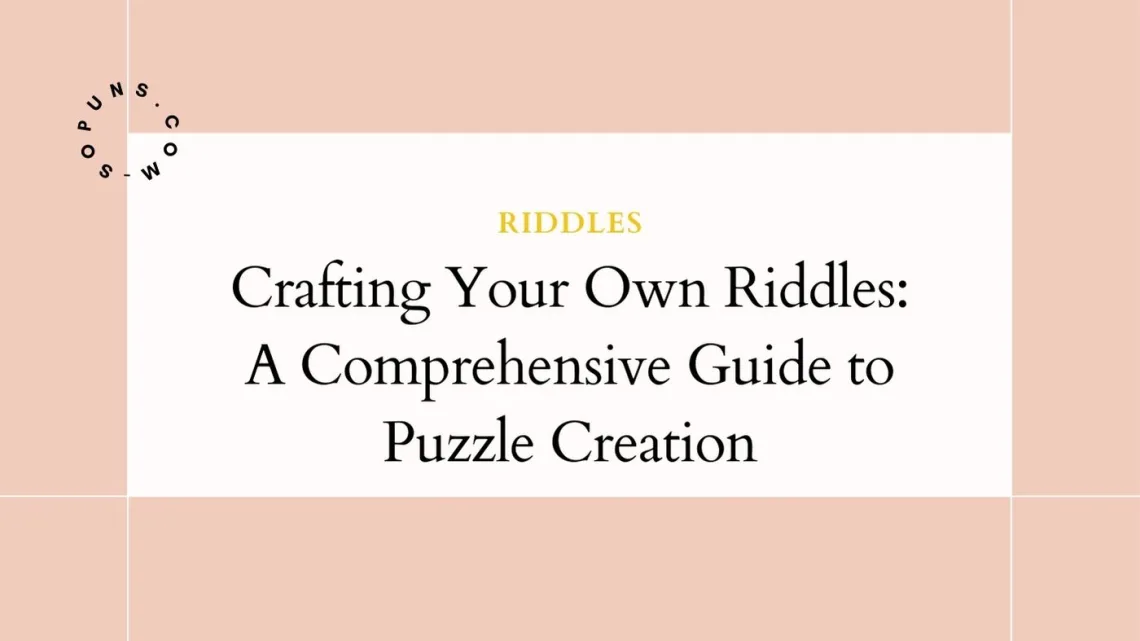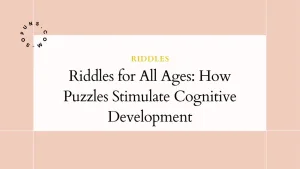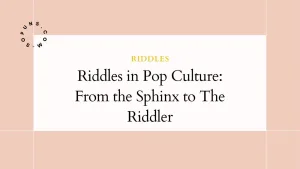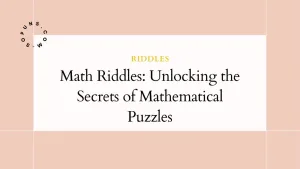Riddles have captivated human curiosity for centuries. The creative process of crafting these brain-teasing puzzles offers an outlet for wit, wordplay, and lateral thinking. This comprehensive guide will walk you through the key steps for creating your own riddles, from generating ideas to testing and polishing your puzzles.
The Art of Riddling
Riddles take many forms, but at their core, they pose a puzzle to be solved through clever insight. A well-structured riddle provides just enough information to point toward the answer without giving it away. Riddle writing relies on creativity, logic, and language skills. While riddling ability may come more naturally to some, anyone can learn how to create their own riddles with practice.
Approach riddle-writing as an intellectual creative endeavor. The most clever riddles integrate wordplay, metaphor, imagery, double meanings, and other literary devices into a compact puzzling format. Riddles reward those able to make connections and think outside the box. Flex your creative muscles and use riddling as an outlet for playful expression.
Building a Solid Riddle Structure
A good riddle provides the key details needed to deduce the answer while withholding the answer itself. The riddle should lead the solver down a specific line of thinking without spelling everything out. Here are some tips for structuring a clear and concise riddle:
- Set up the question – State the riddle as a question to be answered. Open-ended statements rarely work as well.
- Focus on one focal object or idea – Keep the riddle centered on deducing one main answer. Don’t complicate things by introducing multiple solutions.
- Provide crucial descriptive details – Include just enough descriptive hints about the subject to point towards the answer. More vague riddles have too many possible solutions.
- Use metaphor and analogy creatively – Analogies that compare the subject to something different can provide oblique clues that inspire “Aha!” moments.
- Strike a balance between obvious and obtuse – The riddle should steer the solver toward the solution without being too opaque. Allow room for deduction.
- Convey the essence of the answer – Details about the subject should capture what makes it distinctive and recognizable. Stir the solver’s memory and associations.
- Avoid excessive wordiness – Riddles should be pithy and economical. Extraneous verbiage obscures the key clues.
Following these guidelines will help you hone your riddles down to their most crisp and pointed form.
Finding Inspiration for Riddle Ideas

Riddles can be made about almost anything under the sun, but some starting points lend themselves better to riddle fodder. When searching for inspiration, aim for subjects that have intriguing characteristics, metaphors associated with them, or words related to them that can feed into wordplay. Here are some promising areas to spark riddle ideas:
- Word and phrase associations – Homophones, rhyming words, and other word associations can inspire riddle ideas.
- Everyday objects – Common items make convenient riddle topics, especially if they have unique properties.
- Geography and landmarks – Places’ distinctive traits can be fodder for metaphorical clues.
- People, fictional characters, historical figures – Their names or quirks can lead to descriptive riddles.
- Plants and animals – Interesting details about their biology, environment, behavior, and more can inform riddles.
- Food and drink – Cuisine with strong flavors, textures, shapes, and associations works well.
- Visual patterns, optical illusions – Riddles centered on “what do you see?” visuals that reveal images in different ways.
Once you identify promising riddle topics, research key details, attributes, origin stories, and metaphors associated with the subject. This information will help you craft the riddle’s descriptive hints. Lists of “riddle ideas” can also provide inspiration.
Navigating Riddle Difficulty
Riddles should steer towards the “just right” zone of difficulty – not so easy as to be guessed immediately, but not so far-fetched as to leave solvers utterly baffled. Here are some ways to strike the right balance:
- Gauge prior familiarity – Topics more familiar to your audience can sustain more challenging riddles. Obscure topics should come with more guidance.
- Limit permutations – Open-ended riddles with too many possible answers frustrate more than engage. Constraints help narrow down options.
- Watch obscure metaphors – Reach for metaphors that provide strong clues without confounding solvers. Keep them concrete.
- Avoid excessive wordplay – While witty, not all wordplay contributes to cluing the riddle’s core subject. Restrain excessively showy language.
- Check assumptions – Riddles sometimes “make sense” to the creator based on their own mental associations. Test whether the logic tracks for others.
- Try a draft on test solvers – Get feedback to identify any gaps between your perceptions of the riddle and how others interpret it.
- Provide a Plan B hint – Have a backup “nudge” prepared in case solvers get stuck and need an additional clue.
With practice, you’ll gain intuition for how much guidance and wordplay is too little, too much, or just right. Solvers ultimately want the satisfaction of cracking the riddle – not struggling endlessly or having it handed to them.
Incorporating Playful Wordplay
While not mandatory, witty wordplay can amplify the fun and satisfying “aha!” moment of solving a riddle. Here are some ways to spice your riddles up with clever language:
- Double meanings – Use words with multiple related definitions to hint at the answer.
- Homophones – Words that sound alike but have different meanings can point in sly ways.
- Puns – Punny wordplay thrives in riddles, especially rhyming and visually similar words.
- Alliteration and rhyme – These tactics lightly emphasize keywords and create memorable riddles.
- Metaphor – Metaphor allows non-literal comparisons that suggest traits of the answer.
- Analogy – Partial analogies hint at the subject’s role or nature. (“I am to spreading like jam is to…”)
- Anthropomorphism – Assigning human traits to non-human subjects can be suggestive in humorous ways.
- Hyperbole – Exaggeration used artfully underscores distinctive qualities.
The best wordplay contributes to cluing the central answer while also creating moments of insightful delight. Aim for creative language that consistently sustains engagement with the riddle.
Testing and Refining Your Riddles
Like any good writing, riddles require testing and refinement to maximize their quality. Here are some tips for playtesting and polishing your riddles:
- Try out your riddle on friends first – Get feedback from a few friendly test solvers before going public with a riddle.
- Make note of any confusing parts – If testers get caught up on certain words or logic, reconsider those portions.
- Watch for unintended secondary answers – Adjust to close loopholes if testers come up with alternate solutions you didn’t intend.
- Gauge difficulty – Aim for testers to solve in under 2-3 minutes. Faster or slower indicates difficulty issues.
- Ask clarifying questions – Inquire about their thought process to understand where the riddle misleads or connects.
- Try varying the wording – Experiment with different phrasing and word choices and see if they impact the solving process.
- Reduce excess verbiage – Identify any verbose sections that can be distilled down without losing key clues.
- Check grammar, spelling, and punctuation – Refine technical elements to ensure a polished riddle.
Iteratively editing your riddles will help calibrate them for the optimal solving experience. Like a good joke, they should culminate in a rewarding “click” of sudden insight.
Presenting Riddles to an Audience

Once you’ve created some prize riddles, it’s time to unleash them on a wider audience! Here are some tips for effectively presenting your brainteasers:
- Consider your medium – How will you convey the riddle? Written, spoken aloud, a visual prop, etc. Medium effects presentation style.
- Set expectations upfront – Give solvers a sense of the riddle’s theme or tone so they know how to approach it.
- Read/speak the riddle clearly – Enunciate keywords and phrases. Don’t rush or mumble.
- Pause for dramatic effect – Well-timed pauses build anticipation for the “reveal” once someone solves it.
- Keep interactions lively – Respond to guesses and theories in an energetic, encouraging way.
- Give hints if needed – Have follow-up clues ready in case solvers get stuck.
- Provide the answer – Don’t leave everyone hanging! Reveal the solution if no one cracks the riddle after ample attempts.
- Congratulate successful solvers – Let them bask in the glow of victory after deducing the right answer.
Riddles spark connection through shared moments of head-scratching perplexity culminating in satisfied comprehension. Deliver them with flair to create enriching interactions around your creative puzzles.
Leveling Up Your Riddling Skills
Once you’ve mastered basic riddle creation, there are plenty of ways to expand your riddling skills with more advanced techniques:
- Theme riddles – Tie together a series of riddles with a shared motif or story.
- Riddle poems – Craft rhyming poems that embed riddles within them.
- Riddle songs – Set your riddles to music for added memorability.
- Physical prop riddles – Incorporate tactile props into interactive riddles.
- Photo riddles – Provide an image that visually hints at the answer.
- Lateral thinking riddles – These indirectly prod solvers to make mental leaps.
- Mathematical riddles – Number- and logic-based puzzles requiring calculation.
- Double riddles – Riddles with two stages, where solving the first provides a clue to solving the second.
- Story riddles – Riddles couched within a short story context.
There are endless ways to embed riddles into interactive games, performance art, digital media, and other creative mediums. Stay open-minded, and your riddles will continue delighting audiences in new ways.
Troubleshooting Riddle Problems
Creating great riddles involves trial, error, and perseverance. Here are some common riddle issues and ways to overcome them:
Problem: My riddles are too vague, with too many possible answers.
Solution: Add more specific descriptive details to constrain the options.
Problem: My riddles are too obvious and solved immediately.
Solution: Obscure some key traits that directly give it away. Make the clues more indirect.
Problem: I have an amusing play on words but no good riddle to go with it.
Solution: Look for subjects associated with the wordplay that you could build a riddle around.
Problem: I have a subject but no creative metaphors or wordplay for it.
Solution: Research attributes and origin stories around the topic to inspire metaphorical connections.
Problem: Solvers need too many hints to get my riddle.
Solution: Identify any logical leaps required and fill in gaps needed to arrive at the “Aha!” moment.
Problem: People solve my riddle in an unexpected alternate way.
Solution: Incorporate specifics to close unintended loopholes.
Riddle-writing takes practice. Play around with different approaches until you discover your personal style.
Satisfaction Awaits: Get Riddling!
Like any fine craft, riddle creation provides endless rewards when you invest in creativity, practice critical thinking, and engage playfully with language. Approach riddle-writing as intellectual play. The joy comes as much from the creative process itself as from stumping someone with a clever riddle. Soon you’ll be devising mind-bending riddles while waiting in line at the bank, unable to resist weaving words into puzzles. Riddling is infectious – the more you do it, the more naturally witty riddles will spring to mind. So dip your quill into the inkwell of imagination and get riddling!






No Comments